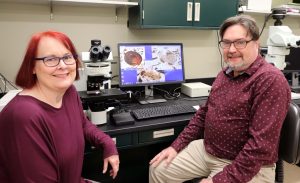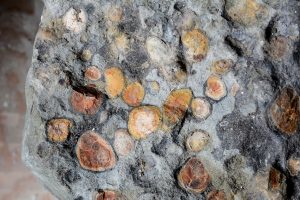With its massive suit of armour and rows of pointy spines, the nodosaur was an intimidating-looking beast.
But for a team of researchers from Brandon University (BU), the University of Saskatchewan (USask) and the Royal Tyrrell Museum of Palaeontology, it’s what’s inside that counts.
The researchers, who included Brandon University Biology Professor Dr. David Greenwood, research associate Cathy Greenwood, and BU Master of Science (Environmental and Life Sciences) student Jessica Kalyniuk, are the first to examine the actual stomach contents of a nodosaur that lived more than 110 million years ago in the area that would later become northern Alberta. While it has long been understood that the 1,300-kilogram nodosaur, a type of ankylosaur, was a herbivore, the opportunity to examine the last meal of the most well-preserved specimen of the creature ever found has provided conclusive dietary evidence that has never been available for a herbivorous dinosaur.

“The discovery of a specimen like this is absolutely remarkable, and the preservation of the plant fragments is evidence that it died shortly after its last meal,” David Greenwood said of the nodosaur, which was found at an open pit mine north of Fort McMurray, Alta. “The vast majority of what we found in its stomach was fern leaves, along with a few stems and twigs. We also found charcoal in the stomach indicating that it was grazing in a freshly burned area, where ferns are some of the first plants that emerge, giving us insight into the way the nodosaur lived.”
The findings of the team, which also included Drs. Caleb Brown, Donald Henderson and Dennis Braman of the Royal Tyrrell Museum, as well as USask geologist Dr. Jim Basinger, have been published by the prestigious Royal Society Open Science this week. The dinosaur specimen, Borealopelta markmitchelli, which has been on display since 2017 at the Royal Tyrrell Museum in Drumheller, Alta., is already a bit of a celebrity, having been featured on the CBC program The Nature of Things last fall.

The study went beyond learning that the nodosaur ate leaves. The Greenwoods, Kalyniuk and Basinger compared the plants to those found in the region at the time to see specifically which plants it was eating, learning that the nodosaur was surprisingly picky, feasting mainly on particular ferns.
For Kalyniuk, the opportunity to contribute to such notable research as a student is very meaningful.
“When I started my MSc., I wasn’t truly aware of how rare fossilized stomach contents are, but the more I learned the more interesting it became to me and the more aware and in awe I was that this is truly unique research,” said Kalyniuk, who graduated from BU with a Bachelor of Science in 2019 before beginning pursuit of her master’s degree. “This has given me an opportunity to get experience at the museum, including hands-on and remote access to their collections, which will play a large role in my thesis work. It has also provided me with new colleagues, resources and support that are of great benefit to me, and I’m sure will continue to be in the future.”

Kalyniuk spent 10 days doing research at the Royal Tyrrell Museum after receiving a grant from the Royal Tyrrell Museum Cooperating Society. If travel restrictions due to COVID-19 permit, she has more fieldwork planned for this year, funded by the US Paleontological Society, including two weeks working with a field crew at Dinosaur Provincial Park in Alberta as well as a trip to USask to study Basinger’s collections of plants from the era.
The research was funded by grants to Greenwood by Canada Foundation for Innovation, Research Manitoba, Natural Sciences and Engineering Research Council of Canada, and grants to other team members from National Geographic Society, Royal Tyrrell Museum Cooperating Society (Kalyniuk) and Suncor Canada.
Contact
- Brandon University
- communications@brandonu.ca
To receive any BU publication in an alternate format please contact Communications@BrandonU.ca
About BU
Success is built at Brandon University. Our growing, progressive campus welcomes a diverse and inclusive community that combines proud tradition with shared ambition. Through our excellence in teaching, research, and scholarship, we educate students to make a meaningful difference as engaged citizens and leaders. Join us at BrandonU.ca.